Far End Crosstalk
When the traces running in parallel has zero length of parallelism, there is no cross talk. As the length of the parallelism is increased, the amplitude of the forward cross talk increases in proportional to the length of the parallelism.
Let us take a look at some simulation results to see the FEXT waveforms and its dependence on various parameters. The hspice code to using a U-element is shown below.
We now present the hspice code, which is similar to that of the near end cross talk. The only difference will be the point of probe in the victim net. We have also changed the length of parallel overlap, as, in case of far end cross talk the amplitude level keeps increasing with the length of parallel overlap length.
If we simulate this, we get a cross talk of -0.128 V
* FEXT Crosstalk, Microstrip
.Tran 50ps 20ns
.OPTION Post NoMod Accurate Probe Method=Gear
VIN 1 0 PWL 0 0v 50ps 0v 350ps 2v
RG 1 2 50
R2 3 0 50
U1 3 2 0 5 6 0 USTRIP L=3000mils
R4 5 0 50
R5 6 0 50
.Model USTRIP U LEVEL=3 PLev=1 Elev=1 Dlev=1 Nl=2 Ht=16mils
+ Wd=12mils Th=1mils Sp=4mils Kd=4.4
.Probe v(1) v(3) v(5) v(6)
.End
We have also used microstrip in place of the stripline. The microstrip structure produces more cross talk than the stripline.
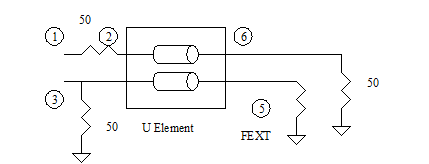
Figure A FEXT simulation
If we simulate this code we get the curves as shown in the figure below.
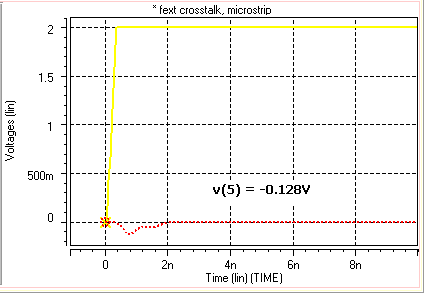
Figure Far end cross talk on Microstrip
In this case it produces a crosstalk of -0.128V
Variation with rise time
If we slow down the edges, the magnitude of the cross talk decreases and its time span increases. The hspice code for simulation is shown below.
* FEXT Crosstalk, Microstrip , variatin with rise time
.PARAM risetime = 150ps
.Tran 50ps 20ns sweep risetime 150ps 550ps 200ps
.OPTION Post NoMod Accurate Probe Method=Gear
VIN 1 0 PWL 0 0v 50ps 0v risetime 2v
RG 1 2 50
R2 3 0 50
U1 3 2 0 5 6 0 USTRIP L=3000mils
R4 5 0 50
R5 6 0 50
.Model USTRIP U LEVEL=3 PLev=1 Elev=1 Dlev=1 Nl=2 Ht=16mils
+ Wd=12mils Th=1mils Sp=4mils Kd=4.4
.Probe v(1) v(3) v(5) v(6)
.End
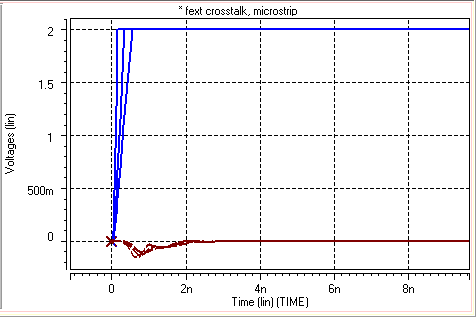
Figure Variation of FEXT with rise time – as rise time increase, crosstalk decreases.
As we see that as the rise time increases, the amplitude of the crosstalk decreases and the width of the cross talk pulse increases.
Table - Variation of Far end Crosstalk with rise time

Variation with length
As we increase the coupling length the amount of the cross talk increases.
* FEXT Crosstalk, Microstrip, variation with length
.PARAM length = 3000mls
.Tran 50ps 20ns sweep length 3000mils 9000mils 3000mils
.OPTION Post NoMod Accurate Probe Method=Gear
VIN 1 0 PWL 0 0v 50ps 0v 350ps 2v
RG 1 2 50
R2 3 0 50
U1 3 2 0 5 6 0 USTRIP L=length
R4 5 0 50
R5 6 0 50
.Model USTRIP U LEVEL=3 PLev=1 Elev=1 Dlev=1 Nl=2 Ht=16mils
+ Wd=12mils Th=1mils Sp=4mils Kd=4.4
.Probe v(1) v(3) v(5) v(6)
.End
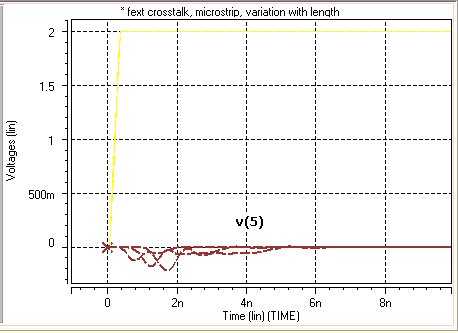
Figure – Variation of cross talk with coupling length

A formula for the Far End Cross Talk Ratio
We define, the ratio of the far end noise voltage to the incident voltage as the FEXT coefficient. The formula for the FEXT coefficient is given by
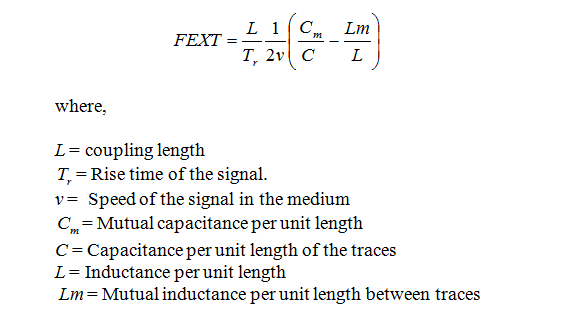
Stripline and FEXT
In case of the stripline, the relative capacitive coupling Cm/C is equal to the relative inductive coupling Lm/L. Because of this there, is no far end cross talk. For microstrips, we can reduce the cross talk by adding a dielectric material on the top surface. The more is the thickness of the material, the smaller is the FEXT coefficient.
Reducing FEXT 1. Reduce the edge rate. A faster edge rate causes more cross talk.
2. Reduce the length for which the trace couple.
3. Route the traces in stripline in place of microstrip.
4. For microstrip add a dielectric layer on the top of signal layer.
5. Increase the separation between the traces.
Previous Next